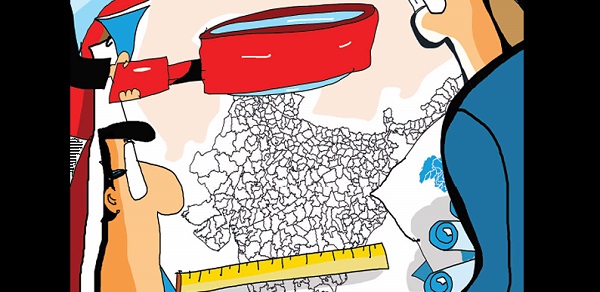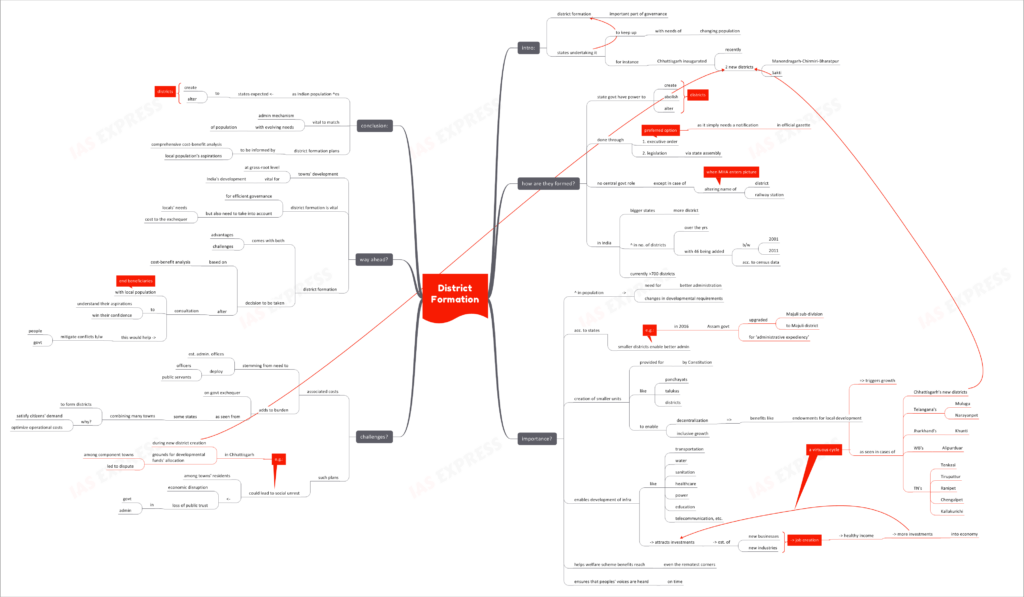District Formation: Importance and Challenges

District formation is an important part of governance. States have been carving out new districts to keep up with the needs of the changing population. Most recently, Chhattisgarh inaugurated its 32nd and 33rd districts- Manendragarh-Chirmiri-Bharatpur and Sakti.

This topic of “District Formation: Importance and Challenges” is important from the perspective of the UPSC IAS Examination, which falls under General Studies Portion.
How are districts formed?
- The state governments are empowered to create or abolish districts, as well as alter the existing districts.
- This is done through an executive order or through legislation in the State Assembly.
- Many state governments prefers the executive route which simply requires a notification to be issued in an official gazette.
- The central government doesn’t have a role in the creation and alteration of the districts. However, the Union Home Ministry enters the picture when the name of a district or a railway station is to be changed.
- Bigger states tend to have more districts compared to smaller states. Over the years, the number of districts in India has been increasing. Between 2001 and 2011, some 46 districts were created, according to the Census data. Currently, there are more than 700 districts in the country.
Why is district formation important?
- The increase in population has increased the need for better administration and developmental requirements.
- The states hold that smaller districts enable better administration and governance. For instance, the Assam government upgraded the Majuli sub-division to Majuli district in 2016 for ‘administrative expediency’.
- The Constitution provides for the creation of panchayats, talukas and districts to enable decentralization and inclusive growth. This decentralized structure enables districts to enjoy benefits, like endowments for local development.
- It enables development of essential infrastructure like transportation, water, sanitation, healthcare, power, education, telecommunication, etc. Good infrastructure attracts even more investments, leading to establishment of new businesses and industries. This in turn leads to job creation for the locals. Good employment opportunities mean healthy income for the people, which would again translate into more investments for the economy, creating a virtuous cycle, triggering growth.
- For instance, Chhattisgarh’s new districts have witnessed development of better roads, other basic utilities like water and power, education, healthcare, etc. Similar boost in development was also seen in case of other districts elsewhere, like Telangana’s Mulugu and Narayanpet, Jharkhand’s Khunti, West Bengal’s Alipurduar and Tamil Nadu’s Tenkasi, Tirupattur, Ranipet, Chengalpet and Kallakurichi.
- Creation of districts help ensure that the benefits of welfare schemes reach even the remotest corners of the country.
- It ensures that the people’s voices are heard on time.
What are the challenges?
- The cost associated with district formation is one of the major limiting factors. This stems from the need to install new administrative offices in the new districts and deploy dedicated officers and public servants.
- The high cost adds burden to the government exchequer. In some cases, state governments combine many towns to form a district to satisfy citizens’ demands and optimize operational costs.
- However, such plans could lead to social unrest among the towns’ residents, leading to economic disruption and loss of public trust in the government and the administration. For instance, during the creation of Chhattisgarh’s latest districts, the grounds for allocation of developmental funds to the component towns led to disputes.
What is the way ahead?
- The development of towns at the grass-root level is vital for the country’s overall development. However, while district formation is important for efficient governance, there is a need to take into account the locals’ needs and the cost to the exchequer.
- In sum, district formation comes with both advantages and challenges. The government must undertake a cost-benefit analysis before taking a decision.
- In such considerations, it is important to consult the local population, the end beneficiaries, to understand their aspirations and to win their confidence. This would help mitigate conflicts between the people and the government.
Conclusion:
As the Indian population grows, the states are expected to alter their internal boundaries, creating and altering districts. This is vital to match the administrative mechanism with the evolving needs of the population. However, district formation plans must be informed by comprehensive cost-benefit analysis and the local population’s aspirations.
Practice Question for Mains:
“District formation in India is a tricky decision.” Discuss (250 words)

